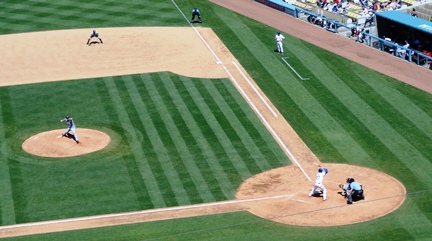Sports
Baseball Strategy
Back to Sports
Back to Baseball
Baseball Rules Player
Positions Baseball
Strategy Baseball
Glossary
Baseball is a complex sport where strategy can play a big part. A baseball team's strategy can vary from game to game depending on the pitcher and the opposing team. The strategy can change during a game from situation to situation depending on the number of outs and the count on the batter. The strategy also changes from batter to batter depending on the strengths and weaknesses of both the batter and the pitcher.
 Photo by Ducksters
Photo by Ducksters
Pitching
Any baseball team's defensive strategy will be centered around the pitcher. The pitcher is the primary defense and how the rest of the defense sets up and plays will depend on the type of pitcher. Some pitchers throw pitches that will cause lots of fly balls. As a result the rest of the defense is positioned and skilled at flagging down fly balls. Other pitches throw pitches that dip and cause lots of ground balls. In this case, a strong infield is necessary.
The pitcher themselves will build up their own unique strategy. Over the years they will work on specialized pitches like the fast ball, curveball, change-up, and slider. Most pitchers will have a couple of pitches that they excel at. Then they will work these pitches to fool the batter. For example, a pitcher may throw a fast ball that whizzes by the batter. When the batter get ready for the next fastball, then the pitcher throws a change-up. The arm motion of the pitcher looks like a fastball to the hitter, but, in fact, the baseball is traveling much slower. The batter often swings too early anticipating the fast ball and completely misses the slower pitch. Pitcher also work the baseball to different areas of the plate. They may pitch a number of high fast balls and then throw a curve ball into the dirt that completely fools the batter. In the end, it's each pitcher's unique strategy that makes them the most effective.
At some professional baseball levels, pitchers will study film of batters and discover their weaknesses. Maybe a batter does not hit an outside fastball well after getting a close in curve ball. The pitcher will then use this knowledge to plan a strategy for getting a particular batter out.
Baseball Fielding Strategy
Fielding strategy is important in getting batters out as well. Often the outfield or infield will shift to the left or to the right depending on the batter. It may be because the batter is left handed or right handed or maybe because the batter typically pulls the ball. They may also shift because they know the pitcher is going to throw the ball inside or outside, so they can predict where the ball is likely to be hit. This positioning gives the fielders a better chance of getting to a hit ball.
Other special positioning in the field is due to the situation of the game. It may be that they are expecting the batter to bunt, so, in this case, the infield would play closer to home plate ready to charge if the batter bunts.
Offensive Baseball Strategy
There is both an individual offensive baseball strategy and a team offensive baseball strategy.
The batter will usually have their own strategy on how to hit a particular pitcher. This usually involves trying to guess the type of pitch that is coming. Knowing the type of pitch can make a big difference on the success of the batter. Batters may study pitchers to know what type of pitches a pitcher prefers on certain counts. They may also study the pitcher's movements to see if they have a specific release or action that tips off what kind of pitch they are throwing. Batter's will also try to read the pitch from the catcher's movements or the spin of the ball coming out of the pitcher's hand.
In team offensive strategy, the baseball coach or manager may make certain calls based on the game situation. One play is called ht hit-and-run. This is case where a base runner starts running as soon as the pitcher throws the pitch. The batter is then supposed to try and make contact with the ball. This puts the batter at a bit of a disadvantage, but gives the base runner a much better chance at advancing. Another example is the sacrifice where the batter intentionally gets an out in order to advance the base runner one base or to home plate for a run.
More Baseball Links: